Development of the economic activity of the population - 4. quarter of 2005
Product Code: e-3133-05
Economic activity of the population in the 4th quarter of 2005
Employment in the primary sector (agriculture, forestry, fishing) decreased by 14.6 thousand to 183.8 thousand persons year-on-year and made up only 3.8% of the total number of first (main) job holders. The number of persons employed in the secondary sector (industry, construction) increased by 39.3 thousand to 1 902.3 thousand (39.6% of total employment). This growth was mainly affected by the year-on-year increase of 38.0 thousand in employment that occurred in ‘manufacturing’. The number of employed persons went up most in ‘treatment and coating of metals; general mechanical engineering’ (+28.3 thousand), ‘manufacture of machinery for production and use of mechanical power, except aircraft, vehicle and cycle engines’ (+12.9 thousand), ‘manufacture of parts and accessories for motor vehicles and their engines (+10.7 thousand) and ‘manufacture of other general purpose machinery’ (+6.4 thousand),). Construction (+6.2 thousand in total) saw considerable increases in employment in the areas of building and civil engineering (+6.8 thousand).
Employment in the tertiary sector (all divisions of services including transport) increased by 45.9 thousand to 2 715.8 thousand (56.5% of total employment), but it developed in the individual divisions in an opposing way. Employment increased most in ‘real estate; renting and business activities’ (+27.0 thousand) ‘education’ (+23.2 thousand), and ‘public administration and defence; compulsory social security’ (+18.9 thousand). Within the section ‘real estate; renting and business activities’ the growth showed mostly in ‘industrial cleaning’ (+9.6 thousand). Within the section ‘education’, it grew most in ‘primary education’ (17.8 thousand). Within the section ‘public administration and defence; compulsory social security’, the number of persons employed in ‘provision of services to the community as a whole’ was up by 13.5 thousand. This increase was apparent in ‘public security, law and order activities’.
On the other hand, employment dropped most year-on-year in ‘wholesale and retail trade; repair of motor vehicles, motorcycles and personal and household goods’ (-21.9 thousand), primarily in ‘retail sale in non-specialized stores’ (-29.6 thousand). Employment dropped also in ‘health and social work’ (-13.7 thousand), most in ‘human health activities’ (-24.2 thousand). The number of nurses and doctors decreased as well as particularly the number of other persons who do not directly belong to special medical staff.
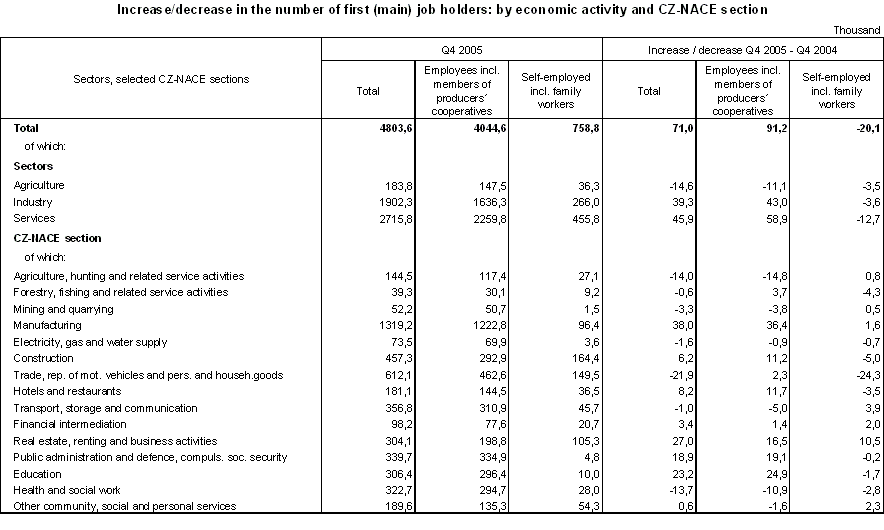
The continuing decrease in the total number of self-employed observed since the beginning of 2004 has been caused in particular by decreasing number of self-employed in ‘trade, repair of motor vehicles, motorcycles and personal and household goods’. Year-on-year decreases in the number of self-employed persons, including contributing family workers, were highest in ‘other retail sale of new goods in specialized stores’ (-8.2 thousand), ‘maintenance and repair of motor vehicles’ (except for motorcycles; -5.0 thousand).
The total employment rate of persons aged 15-64 grew year-on-year by 0.6 percentage points to 65.1%. The relative increase was higher in the employment of men at working age (+0.7 percentage points to 73.6%), while employment of women was 0.6 percentage points up and reached 56.7%. The employment rate is pushed down by a fast growth of the number of students at universities on the one hand, and, on the other hand, there is an increasing involvement of persons in employment throughout the whole working age interval 30-64 (except the 45-54 age group).
Compared internationally, the Czech Republic is among the countries with the above-the-average employment intensity in the EU. According to the latest complete data for Q2 2005 released by Eurostat, the employment rate of persons aged 15-64 in the Czech Republic was higher than the total for EU25 and not far from the level in the EU15 (however, we should take account of the fast growth of this indicator in the CR during the whole of the last year). Nevertheless, differences in employment rates are considerable, not only if we compare the whole age group 15-64 (in Q2 2005 75.5% in Denmark and only 52.2% in Poland), but also in the male and female components of employment.
According to a decision of the European Council taken in Lisbon 2000 (the Lisbon Strategy) or in Stockholm 2001, the EU member states should reach an employment rate of 70% in the age group 15-64 up to 2010. Four countries (Denmark, the Netherlands, the United Kingdom and Sweden) reached this level in Q2 2005, and some other EU member states are not far from reaching it. It is obvious, however, that some of the new member states (in particular Poland, Malta, Slovakia and Hungary) will have difficulty meeting this goal, and so will some of the EU15 states (especially Greece, Italy and Luxembourg).
The following table shows employment rate for the age group 15-64 in the EU member states in Q2 2005 where complete data were available (for Luxemburg data of Q4 2004 for the calculation of the EU total were used) and updated data for Q3 2005 are also given.
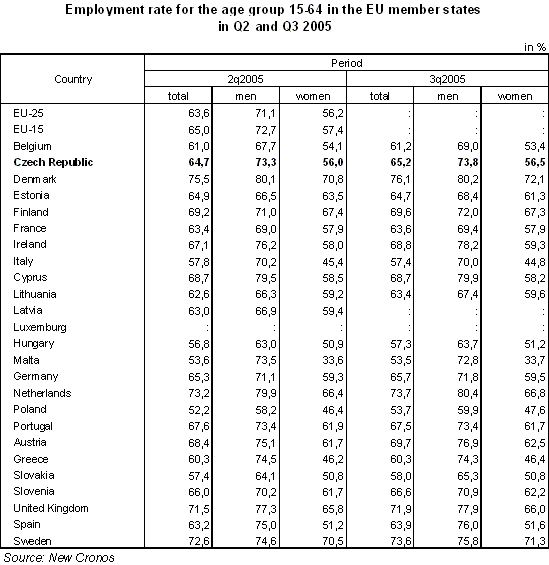
Differences in the employment intensity are considerably affected by legislation in force in individual states, which specifies the age and conditions for normal or early retirement. On top of the aforementioned goal, the Lisbon Strategy supposes that an employment rate of 50% for the age group 55-64 should be reached up to 2010. The CZSO analysis Development of the economic activity of the population in the 3rd quarter of 2005 provided for detailed data on employment rate of men and women in higher working age and retirement age. While the employment rate of men aged 55-59 in the Czech Republic was the fourth highest in the whole EU, the employment rate of women was roughly in the middle of the interval of European Community countries. More complicated situation is of persons in the age group 60-64 where in the Czech Republic the employment rate of men as well as of women is lower.
Creation of favourable conditions and job opportunities for persons at the pre-retirement and young retirement age but also at the lower and middle working age should decisively influence the employment rate throughout the working age interval 15-64. One of the possibilities is a broader utilisation of part-time jobs, which are in the Czech Republic used by a substantially lower percentage of persons than on average in all the EU25 states, particularly in the EU15. Only two countries from the EU have the share of employees working part-time lower than in the Czech Republic. A very low share of part-time jobs is not only among the group of women but also the share of men working part-time is in the Czech Republic along with Slovakia much lower than in the other EU countries. At the same time, for example in the Netherlands there is more than a fifth of working men and three quarters of working women who take advantage of this opportunity.
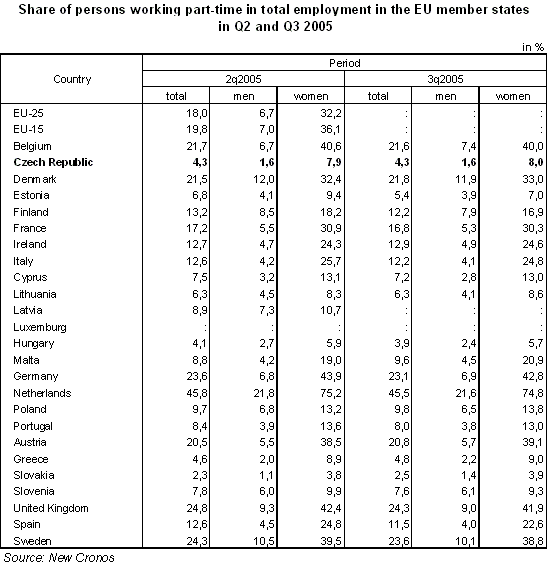
The employment of persons living in the individual regions of the Czech Republic dropped year-on-year only in two of them, most in the Liberecký Region. On the other hand, the number of employed persons increased particularly in the Hl. m. Praha, Moravskoslezský Region, which, in other respects, chronically suffers from high unemployment and the Pardubický Region.
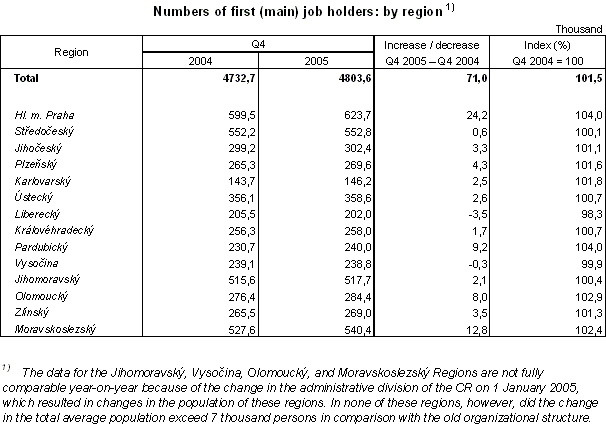
With the growing total employment of the residing population, the number of the economically inactive and the number of the unemployed decreased. The number of unemployed persons (ILO methodology) reached 404.8 thousand on average in Q4 2005, i.e. a fall of 15.4 thousand year-on-year. The number of the unemployed decreased mainly in the age group 20-29 by 26.6 thousand, it also dropped in the age group 40-44 by 2.4 thousand and in the age group 60+ by 0.9 thousand. The number of unemployed men (175.4 thousand in total) is still below the number of unemployed women (229.4 thousand). Under the total year-on-year drop in unemployment, the unemployment of men decreased by 20.4 thousand, and the decrease was the biggest in the group of 20-29-year-old persons (-19.1 thousand). Over the same period, the number of unemployed women increased by 5.0 thousand in total, and this increase occurred in the remaining working age interval of 30-60 years.
The number of persons unemployed for a long time (1 year or more) fell by 3.1 thousand. In spite of this total drop, a high increase was recorded among men aged 15-19 (+4.4 thousand) and women aged 40-49 (+3.5 thousand).
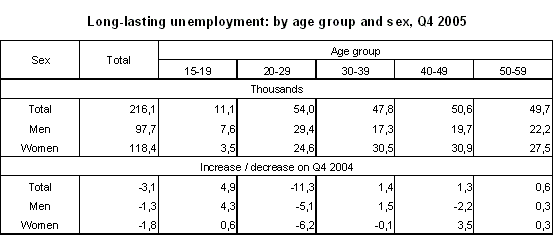
The number of the unemployed with basic education decreased by 7.7% year-on-year to 97.5 thousand and that of unemployed persons with secondary education without GCSE (with secondary vocational education in particular) decreased by 4.4% to 193.5 thousand. The number of the unemployed with secondary (with GCSE) and higher educational attainment decreased by 2.3% to 95.0 thousand and the number of unemployed university graduates rose by 26.8% to 18.8 thousand. The unemployment of university graduates is, however, still markedly lower when compared to the first three groups.
Year-on-year, the unemployment dropped particularly in the Olomoucký, Moravskoslezský Regions and the Hl. m. Praha; the situation deteriorated especially in the Zlínský and Jihomoravský Regions when compared to Q4 of the last year.
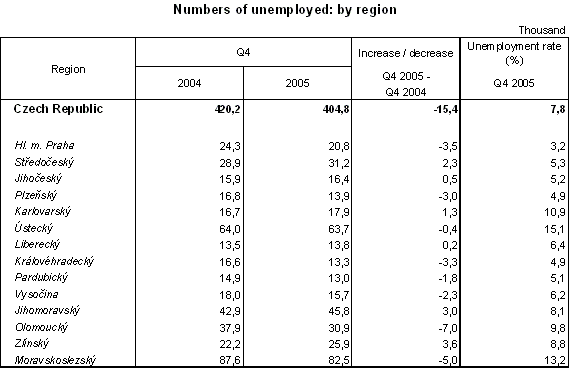
The growth of total employment and the decrease in the number of the unemployed resulted in a relatively high decrease of general unemployment rate (ILO). In comparison to Q4 2004, the general unemployment rate decreased by 0.4 percentage points to 7.8%. It decreased only among the male population (by 0.8 percentage points to 6.0%) while it remained unchanged among the women population (9.9%). The general unemployment rate in the Czech Republic is lower than the average of the whole Community; the problem, however, is the relatively high share of the long-term unemployed (1 year and more).
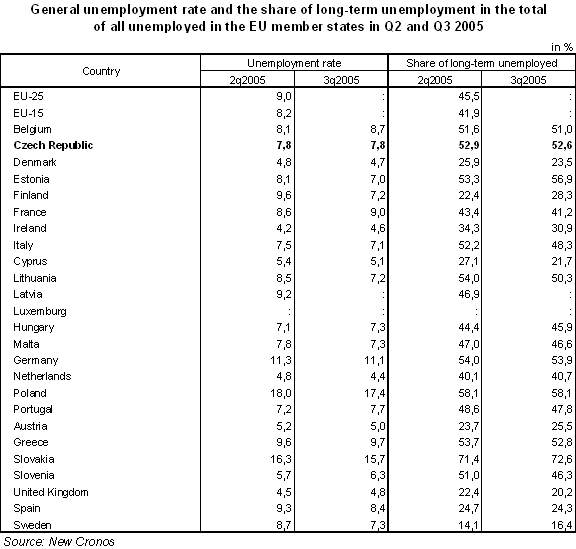
The number of economically inactive persons aged 15+ (according to the LFSS methodology they are persons who had no job and were not seeking a job during last four weeks or did not meet all conditions for being classified among the unemployed) decreased by 0.5 thousand year-on-year and reached 3 533.8 thousand in Q4 2005. This category is primarily affected by numbers of the retired and of persons preparing for their future occupation. The number of basic school pupils increased by 10.9 thousand; the number of apprentices decreased by 7.5 thousand; the number of secondary school pupils went up by 1.9 thousand to 380.7 thousand; the number of university students including higher professional school students grew rapidly by 11.0 thousand to 269.5 thousand. The number of economically inactive normally retired persons not actively seeking job increased by 12.2 thousand to 1 832.5 thousand and the number of persons in early retirement fell by 5.3 thousand to 69.4 thousand. Furthermore, the number of disability pensioners decreased by 3.2 thousand to 314.3 thousand. These figures cannot accurately correspond to the statistics on pupils and students compiled by the Ministry of Education. Youth and Sports of the CR or to the numbers of pensioners on the records of the Ministry of Labour and Social Affairs of the CR because the pupils. students or pensioners who fulfilled the criterion of being classified among persons in employment or unemployed persons in the reference week are not reported as economically inactive
